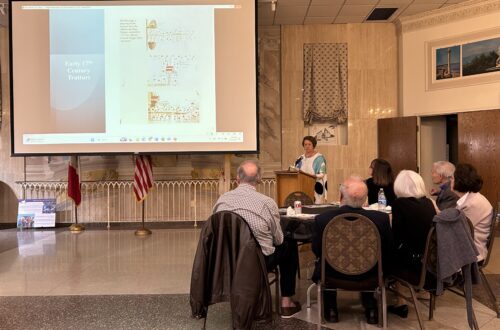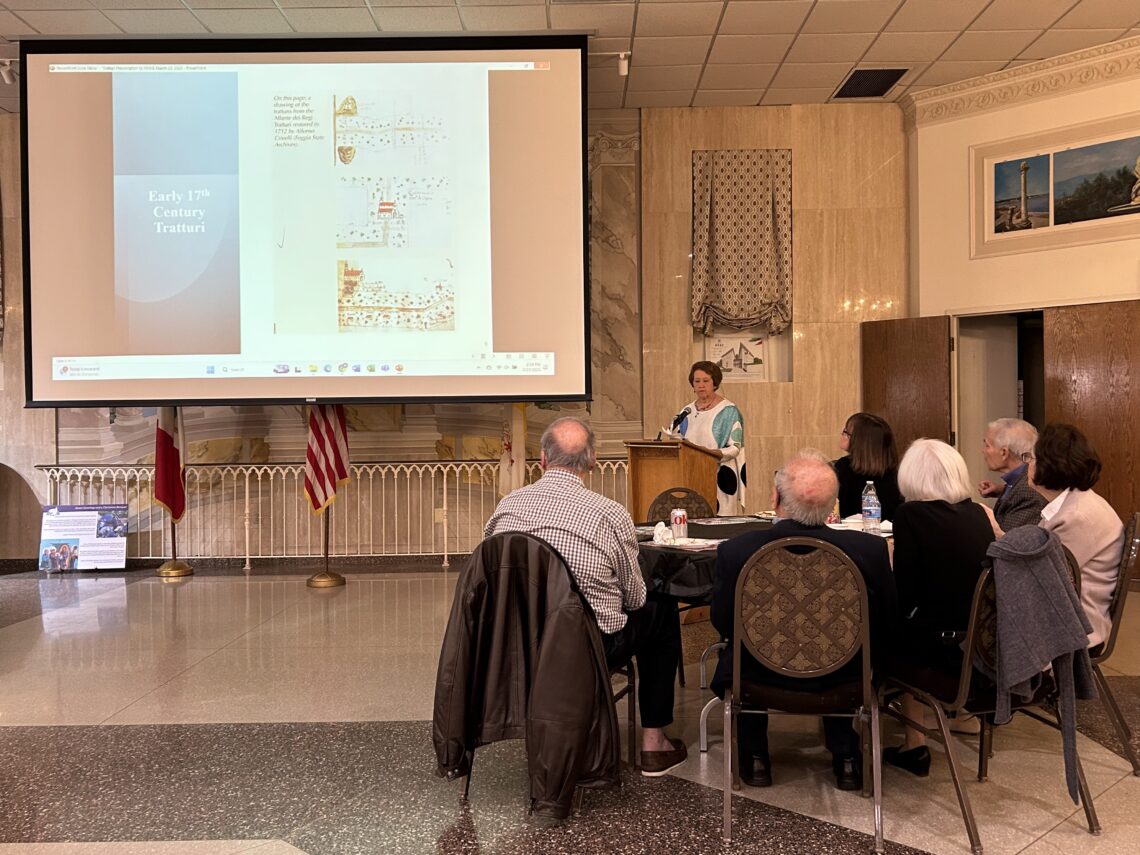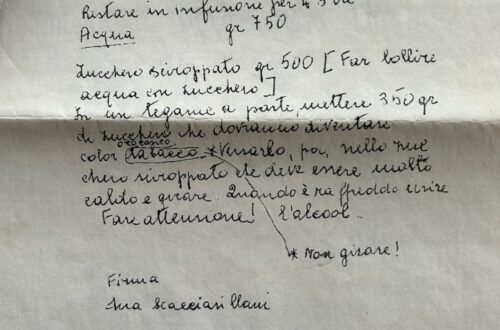-
A Grandson’s Quest for Real Poncio

Dominic Palumbo’s Poncia in the infusion stage. Our story starts with an email sent to the AMHS in March 2025. Dominic Palumbo, a farmer at Moon in the Pond Farm and educator at Farm education, Inc., in Sheffield, Mass., wrote the following:
“My grandparents (Vincenzo Palumbo and Anna Scacciavillani) emigrated from Frosolone in Campobasso in 1903-5(?). I visited Frosolone in the late ’90s. My great-aunt, Vera Scaccivillani (about 85 yrs. old at the time) wrote out her recipe for the liquore, Poncio, for me. (She served it to me, and I loved it sooo much!) I have resurrected the copy but I’m having trouble reading her handwriting and translating it. Perhaps some of your members may be able to help. For the historical aspect, I’m most interested in a direct transcription, as much as possible (rather than an interpretation of what she may have meant)… as well as the interpretation of ambiguous aspects!)
I am most grateful for any help you may be able to give!
Please feel free to share the recipe with your members and please include attribution.
Sincerely,
Dominic Palumbo “What is Poncio? According to the website deliciousitaly.com, Poncio is the most typical of the Molisan liquors and goes on to say, “This drink originated as a home made brew before becoming widely available in the bars and pasticcerie shops of the region.The origin of the name remains unclear and the best guess is that it is an Italianised (sic) version of the English word ‘punch’.”
https://www.deliciousitaly.com/molise-food/local-liqueur-of-molise
AMHS President Chris Renneker sent the email to Board Member, and Molise native, Natasha Rovo, who went to work. the result is below.
Original recipe given to me (Dominic Palumbo) by my great aunt Vera Sciacciavillani in Frosolone in ~1998:
Transcription and translation below by Natasha Rovo of the Abruzzo-Molise Heritage Society (Wash, DC)—
In Italian:
Poncio di Vera Scacciavillani (moglie di zio Franceschino) Alcol gr 500 + buccia di limone + buccia mandarino + qualche acino di caffe Restare in infusione per 48 ore Acqua grammi 750 Zucchero sciroppato grammi 500 (far bollire acqua e zucchero) In un tegame a parte, mettere 350gr di zucchero che dovranno diventare color tabacco (non girare). Versarlo poi nello zucchero sciroppato che deve essere molto caldo e girare. Quando e’ rafreddato, unire l’alcol. Fare attenzione! Firma, Vera Scacciavillani
In English:
Poncio by Vera Scacciavillani (uncle Franceschino’s wife) Alcohol 500g + lemon peel + mandarin peel + a few coffee beans Leave to infuse for 48 hours Water 750g Sugar in syrup 500g (boil water and sugar) In a separate pan, put 350g of sugar that must become tobacco colored (do not stir). Then pour it into the sugar in syrup that must be very hot and stir. When it has cooled, add the alcohol. Be careful! Signature, Vera ScacciavillaniDominic took things a step further. As he wrote:
I made my own intuitive (significant) changes/adjustments to the original recipe as I thought I might prefer:
guessed on the volume (I used lots) of citrus peels and included some (navel) orange peel.
used the whole peel of mandarins and lemons but only the zest of navel oranges.
I juiced the citrus and reserved the juice to replace part of the volume of water. I made a more concentrated syrup (reducing the amount of water by the volume of reserved juice) then added the juice to the cooled syrup.
used a significant quantity of coffee beans vs. “a few”
Infusion:
500 ml (XXX) 190’ grain alcohol combined with
500 ml water
250 gr mandarin peels (whole) (~ 12 mandarins)
55 gr navel orange peels (zest only) (~3)
165 gr lemon peels (whole) (~3)
100 gr coffee beans
1 tbls. ground coffee
Syrup:
1000 gr sugar
1500 ml water (subtracted volume of juice of above citrus—see note below)
Caramel:
700 gr sugarInfusion:
Using a veg. peeler, zest oranges. Halve all citrus and juice—strain through cloth and reserve juice in refrigerator. Infuse citrus peels and coffee beans in alcohol (if XXX, alcohol/water combo.) for 1 week, turning daily and pressing peels down into alcohol. At the end of the week, strain infusion. Then make syrup and caramel—
Syrup:
Measure juice volume. Subtract juice volume from water volume. (1500). Combine sugar and remaining water. Heat (almost boil) to dissolve.
Caramel:
In a non-reactive, wide vessel, melt sugar over med-high heat, without stirring, to caramelize. When it is very dark brown, immediately but CAREFULLY add to hot syrup (above). Stir to combine, then allow the mix to cool completely.
Combine and Age:
Combine cooled syrup-caramel mix with reserved strained juice and strained alcohol infusion. Let rest and age for about 6 months. (It definitely improves with age!) Enjoy!The 2025 result was/is a very tasty liquor, although quite sweet. Next year I will attempt to offset/balance the sweetness by increasing the bitterness. I will increase the proportions of citrus peel (25-50%?), and I will take the caramel to a very dark (already noted above!) color (more towards the darkest tobacco vs. golden tobacco!), and I will increase the alcohol content slightly (10-20%?).
Please let me know your attempts/results/ideas!
Enjoy!
Summer 2025
-
Along the Shepherds’ Tracks: Traturri and Transumanza
By Carmine Spellane
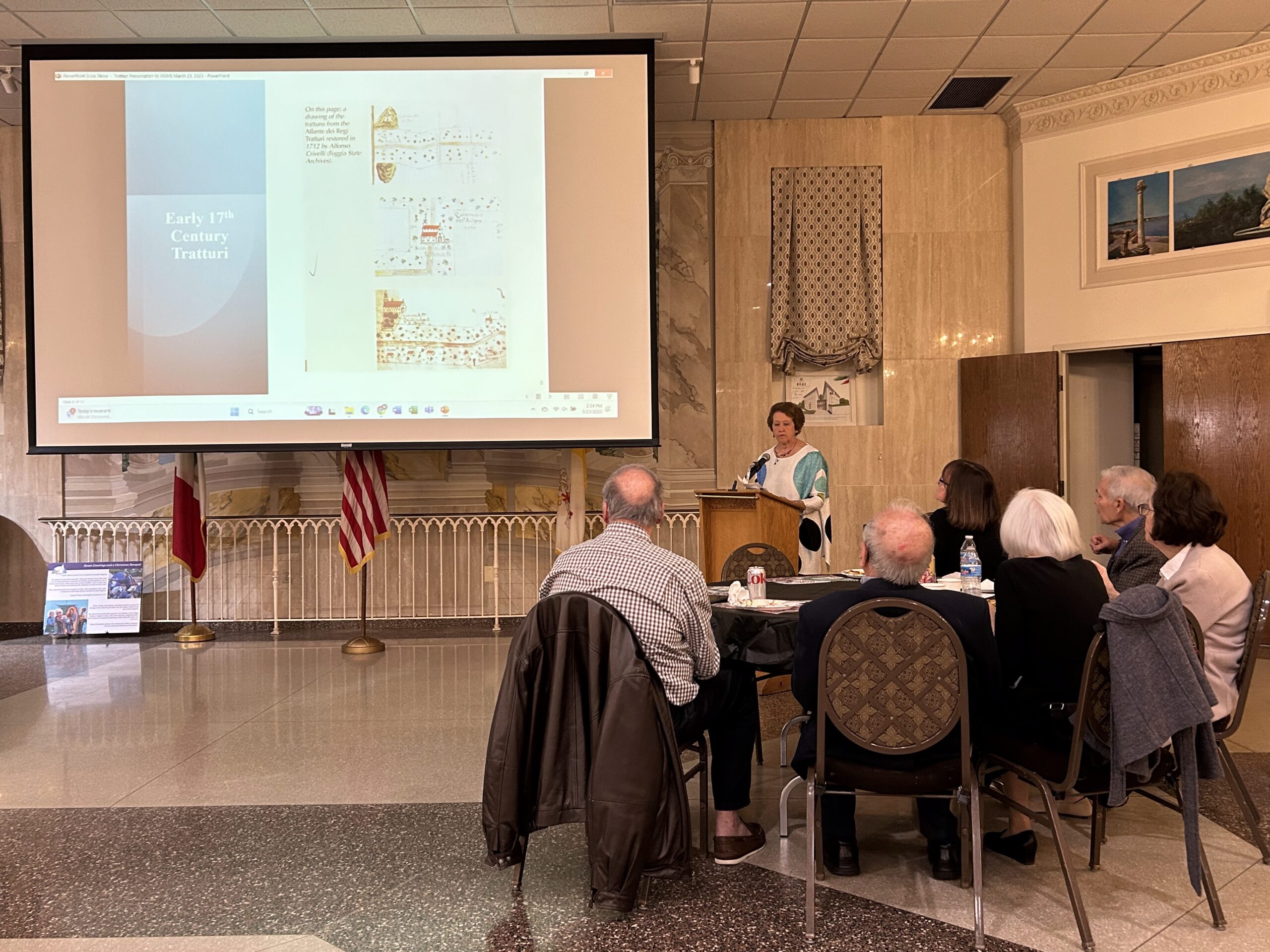
Maria D’Andrea-Yothers reprises her presentation on the Tratturri and Transumanza.
At the most recent AMHS general meeting, held on March 23 at Casa Italiana, former Society President Maria D’Andrea-Yothers reprised her presentation on the famed herding trails in Abruzzo and Molise, known as the trattoria which make up the interconnected system known as the transumanza.
Maria said that people who have had the pleasure of visiting Abruzzo and Molise, traveling on roads connecting various villages and towns, might have noticed something relatively new – markers placed on the shoulder of these roads reminding travelers that they are approaching a “tratturo”, or track, not easily visible, that, over time, formed a path in the seasonal migration of sheep and other animals, referred to as the “transumanza”. The term derives from the Latin “trans” (across) and “humus” (ground).
Maria recounted how, since the earliest days of ancient history, the story of Abruzzo and Molise has been shaped by the harsh mountainous character of its territory. The regions, containing the two highest mountain groups of the Apennines – the Gran Sasso and the Majella Massifs – with peaks close to 3, 000 meters, or 10,000 feet – have been conditioned by the traditions and lifestyle of sheep-rearing communities. Their high-altitude valleys, rocky slopes, and vast mountain plains have been the ideal environment for sheep and shepherds.
For centuries, sheep-rearing provided a livelihood for more than half the population of Abruzzo and Molise and, from pre-Roman times until recently, was the basis of their economies, social fabrics, and cultures, shaping population spread, landscape (both natural and agricultural), layout of towns and villages, and the earliest communication routes.
The shepherd’s tracks are routes used by livestock linked to the transumanza, a type of grazing based on the seasonal movement of herds between various regions with different climate. When the lower plains become arid because of the heat, herds and shepherds move to the mountains in spring and return to the plains in autumn. In Italy, these tratturi cross the regions of Abruzzo, Molise, Puglia, Campania, and Basilicata.
Research has identified five main “traturri” in the regions: L’Aquila-Foggia (blue); Centarelle-Montesecco (yellow); Celano-Foggia (red); Pescasseroli-Candela (pink); and Ateleta-Biferno (green).
These “tratturi” extended for distances of 250 to 300 kilometers, or from 150 to 200 miles, and followed well-developed routes, established over centuries of regular use. From the Roman period onward, and in particular during the reign of the Aragonese (Spanish occupation of parts of Italy in the 11th to 15th centuries), these routes were rigidly determined and legally protected by edicts issued by the regions’ governors.
The stability for the seasonal movement of flocks between the two regions and Puglia was provided by the institution of laws, “Lex Agraria Epigraphis” (agrarian laws), designed to regulate the use of public grazing lands and routes for the movement of livestock or “calles”, later known in Italian as “tratturi”.
During the Middle Ages, seasonal migration almost came to a halt, due to political destabilization and feudal conflicts, making the “tratturi” unsafe. “Transumanza” surfaced again under the Normans in the years from 1000 to 1200 A.D., primarily due to the influence of the Benedictine monks.
These monks had a profound impact on the social, economic, and cultural development of the region, contributing to the promotion of sheep rearing, which made the region of Abruzzo Europe’s leading producer of wool. Government regulation of these enterprises came about under Spain’s King Alfonso I of Aragon, who established a “dogana”, or custom house, in Foggia, Puglia, for the collection of taxes and duties from the use of the tratturi and grazing rights for the sheep. Regulations were also established for the time of the year the livestock were permitted to migrate. In early May, all forms of livestock migrated to the Appenine pasture, whereas the migration to the south, toward Puglia, was more diversified: sheep and goats entered Puglia in mid-September, and cattle in mid-December.
In the beginning of the 15th to the 16th century, sheep rearing began to decline, accelerated by a shift in land use from grazing to farming, as laws were enacted to encourage the growing of crops. The economic transformation began to destroy the traditional interdependent system of agriculture and sheep rearing on which the economies of the two regions had been based for centuries. Many villages that once were mainly devoted to the raising of sheep, wool, cheese, etc., began to be de-populated and in some cases were abandoned all together.
Maria also offered some observations on the shepherds – these sturdy, dedicated men who cared for the animals. During the seasonal migration, shepherds would walk hundreds of kilometers in the company of their livestock, a walk that would average three weeks or more to reach the grazing pastures. This trek would include nightly stopovers involving the setting up of temporary fences known as ‘stazzi’ to keep the sheep contained and a roof over the shepherd’s head.
The shepherds shared their living conditions with their flocks. It was a rugged life, lived in isolation, in the open, physically bound to the caring of their flocks for 10 to 11 months out of the year, and also conditioned by the grazing needs of the flocks and available pastures.
The diet of the shepherds was very simple and austere: bread, complemented by herbs and vegetables such as chicory, onions, and plenty of salt. Besides a meager wage, shepherds were given a kilo of bread daily.
Dry-stone huts served as shelters for the shepherds and enclosures for the livestock. The conical shape of the roof looks like the “trulli” from Puglia, but in Abruzzo, they are called “palace.”
Some huts were about 6 meters (20 feet) in height and were built by placing an ever-decreasing concentric layer of limestone slabs on top of each other so that the wall would close in to form the conical roof. Caves were common in the lower elevations; the caves were very sparse and rustic but served the needs of both sheep and goat herders.
The Cane da Pastore Maremmano Abruzzese, or Mastiff, was and is critical to the survival and care of the shepherd and his flock. The dog is the product of a rich tradition of sheep rearing in Abruzzo. They are considered one of the best breeds in the world for protecting sheep from wolves, bears, and other predators.
Maria noted that since the late 1970s, a number of Ministerial Decrees have recognized the historic and artistic importance of the tratturi, offering various forms of protection. These decrees also allowed for the transfer of the tratturi, the land, and the livestock, from the state to local regional bodies.
A concerted public appreciation and awareness of the “traturri” has given energy to restore their historical significance to the regions’ rich cultural heritages. They offer unique tourist attractions for trekking and horseback riding that have become very common in recent years. The preservation of the tratturi has made the “transumanza” an original and unique patrimony.
Today, tourism companies have found ways to amplify the importance of the traturri to more and more visitors to the region. For example, Hidden Trails offers an eight-day, seven-night trip that starts in Isernia, Molise into Abruzzo, following the tratturi on two mountain treks, the Parco Nazionale della Majella and the Parco Nazionale d’Abruzzo.
The tratturi have also been memorialized by Gabriele D’Annunzio, the famous poet of Abruzzo, in his poem titled “I Pastori,” which was included in the collection Alcyone – Sogni di terre lontane composed between 1903 and 1907.
Starting with the famous words “Settembre, andiamo…” It is a nostalgic poem, written by D’Annunzio while he was away from his homeland and longing for its colors, tastes, sounds, and mountains. Maria asked Natasha Rovo to read the poem in Italian. (To read the poem in English and Italian, click HERE.)
The presentation marked Maria’s final appearance at an AMHS meeting. She and her husband, Sam Yothers, are moving to North Carolina in the summer. The assembled members and friends wished Maria a fond farewell and heartfelt thanks to her many contributions to the Society.
Summer 2025
-
Influential Novelist and Screenwriter John Fante
By Joseph “Sonny” Scafetta, Jr.

John Fante
Credit: WikipediaOften referred to as the quintessential L.A. novelist and a precursor to the Beat writers of the 1950s, John Fante was one of the first novelists to portray the tough times for writers during the Great Depression. John Fante also had roots in Abruzzo.
John Fante was born on April 8, 1909, in Denver, Colorado. His father Nicola had emigrated from the town of Torricella Peligna (population 1,520 in the 2008 Census) in the province of Chieti in the region of Abruzzo. His mother was Mary Capolungo, a devout Catholic whose parents had emigrated from the region of Basilicata in southern Italy. Nicola was a bricklayer and a stonemason. However, he was also an alcoholic and a gambler, so his family was often in poverty. Fante attended Catholic elementary schools. He graduated from St. Regis High School in June 1927. He enrolled in the University of Colorado, but dropped out after two years to write. Without any success in Denver, he hitchhiked in 1933 to Los Angeles to focus on his writing. There he met Joyce Smart on January 30, 1937. They were married six months later in Reno, Nevada, on July 31. They then moved to Malibu and had four children. Soon thereafter, his short story “Altar Boy” was published in the highly regarded literary magazine The American Mercury whose editor, H. L. Mencken, helped Fante get his first novel, Wait Until Spring, Bandini, published in 1938. In the next year, his greatest novel, Ask the Dust, which was semi-autobiographical, was published. It is a story about Arturo Bandini, a struggling writer in Depression-era Los Angeles. It is considered the great Los Angeles novel. His short story collection, Dago Red, appeared in 1940. Later that year, he started writing movie scripts with his drinking buddy, William Faulkner. Fante’s next novel, Full of Life, was printed in 1952 and later made into a movie starring Richard Conte. In 1955, Fante was diagnosed with diabetes which caused him to go blind. Nevertheless, he next co-wrote the screenplay for the movie, Walk on the Wild Side, which starred Jane Fonda. His other screenplays written from 1957 to 1962 included Dinky, Jeanne Eagels, My Man and I, The Reluctant Saint, Something for a Lonely Man, and Six Loves. In 1970, he published the novel, Bravo, Burro! Next, he published the novel, The Brotherhood of the Grape, in 1977. Later that year, he had his legs below the knees amputated because of his diabetes. His last published novel while he was living was Dreams from Bunker Hill in 1982. Fante died on May 8, 1983, in Los Angeles, one month after his 74th birthday. His short story collection, Dago Red, was re-published with more short stories as The Wine of Youth in 1985. Later that year, Fante’s unpublished novel, The Road to Los Angeles, was printed. Also, an incomplete novel was found by his wife and published as 1933 Was a Bad Year. In 1986, she found and had published a novella, West of Rome. Fante’s personal correspondence with Mencken from 1930 to 1952 was published in 1989. Also, later that year, a movie version of Wait Until Spring, Bandini was released. On January 18, 2001, a play entitled 1933, based on Fante’s novel, premiered in the Denver Center for the Performing Arts. In March 2006, Paramount Pictures released the movie, Ask the Dust. In December of that year, a documentary film, A Sad Flower in the Sand, about Fante aired on the PBS series, Independent Lens. On April 8, 2010, his 101st birthday, a Fante Square sign was unveiled at the intersection of 5th Street and Grand Avenue in the old Bunker Hill neighborhood that he wrote about. In October 2019, a French film, Mon Chien Stupide (My Dog Stupid), was released. It was based on a story in Fante’s novella, West of Rome.Sources: (all accessed April 10, 2025)
en.wikipedia.org/wiki/John_Fante
en.wikipedia.org/wiki/Torricella_Peligna
en.wikipedia.org/wiki/Basilicata
Summer 2025
-
CASTEL DI IERI

By Nancy DeSanti
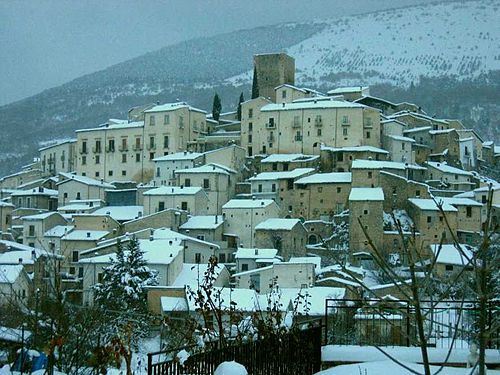
A view of Castel di Ieri.
Credit: WikipediaProvince of L’Aquila, Region of Abruzzo
The beautiful small town of Castel di Ieri is located in the province of L’Aquila. It has
approximately 326 inhabitants, known as Casteldieresi.
Situated on a small hill dominated by a massive tower of the 15th century, it has typical
medieval houses, together with the Church of the Assumption with a beautiful Renaissance
portal. The majestic tower in the form of a pyramid dominates the most ancient part of
the village, allowing a panoramic view of the zone. The houses constructed outside of the
walls were constructed at the end of the 19th century.
The history of Castel di Ieri dates back to the 7th and 8th centuries B.C. Not far away,
there were found relics of pre-Roman times. The city, known as Catrum Hilare, Perio
Castle, and also Iesio Castle, was a fiefdom of the Barberini family.
In 1522, Castel di Ieri was destroyed by a great fire but was soon reconstructed due to the
efforts of the community. In 1860, the town was annexed to the Kingdom of Italy, and in
1927 it was created as the municipality of Castel di Ieri. During the second world war, the
town was occupied by the Germans from 1943 to 1944 and suffered extensive damage and
looting.
The cultural patrimony of Castel di Ieri is considered very rich. Among the main
attractions there are the Tower of the Castle and the Cathedral of Saint Mary Assumed into
Heaven. Every year, on the occasion of the feast of the patron saint, there are organized
festivals, concerts, theater spectacles, and sporting events. In addition, every year there
takes place the Prosciutto di Castel di Ieri festival, during which one is able to taste local
specialties and typical products of the zone.
Castel di Ieri is a very beautiful little town where a peron is able to spend time in
tranquility, surrounded by the beauty of nature and thee cultural patrimony. Due to its
geographical position, to the pleasant climate, and to the rich history, Castel di Ieri offers to
the visitors the opportunity to immerse themselves in an authentic Abruzzese environment,
rich in traditions and natural beauties.What to See
Church of Saint Mary Assumed into Heaven
Tower of the 15th Century
Important Dates
- June 21 – Prosciutto Fair
- · August 7 – Feast of St. Donato
- · September 2-3 – Market Fair
Italiano

Tradotto da Ennio Di Tullio
Provincia di L’Aquila, Regione Abruzzo
La bella cittadina di Castel di Ieri si trova in provincia di L’Aquila. Conta circa 326
abitanti, noti come Casteldieresi.
Situata su una piccola collina dominata da una massiccia torre del XV secolo, ha tipiche
case medievali, insieme alla Chiesa dell’Assunta con un bel portale rinascimentale. La
maestosa torre a forma di piramide domina la parte più antica del paese, consentendo una
vista panoramica della zona. Le case costruite fuori dalle mure furono costruite alla fine
del XIX secolo.
La storia di Castel di Ieri risale al VII e VIII secolo a.C. Non lontano, sono stati trovati
resti di epoca preromana. La città, nota come Catrum Hilare, Castello di Perio, ed anche
Castello di Iesio, era un feudo della famiglia Barberini.
Nel 1522 Castel di Ieri fu distrutto da un grande incendio ma fu presto ricostruito dovuto
agli sforzi della comunità. Nel 1860, il paese fu annesso al Regno d’Italia, e nel 1927 fu
creato come il comune di Castel di Ieri. Durante la seconda guerra mondiale, il paese fu
occupato dai tedeschi dal 1943 al 1944 e subì ingenti danni e saccheggi.
Il patrimonio culturale di Castel di Ieri è considerato molto ricco. Tra le principali
attrazioni ci sono la Torre del Castello e la Cattedrale di Santa Maria Assunta in Cielo.
Ogni anno, in occasione della festa del santo patrono, vengono organizzate sagre, concerti,
spettacoli teatrali, ed eventi sportivi. Inoltre, ogni anno si svolge la sagra del Prosciutto di
Castel di Ieri, durante che si possono gustare specialità locali e prodotti tipici della zona.
Castel di Ieri è una bellissima cittadina dove una person possa trascorrere del tempo
in tranquillità, circondati dalla bellezza della natura e del patrimonio culturale. Dovuto
alla sua posizione geografica, al clima piacevole, e alla ricca storia, Castel di Ieri offre
ai visitatori l’opportunità di immergersi in un autentico ambiente abruzzese, ricco di
tradizioni e bellezze naturali.Attrazioni del luogo:
Chiesa di Santa Maria Assunta in CieloTorre del XV secolo
Date da ricordare:
21 giugno – Prosciutto Fiera7 agosto – Festa di San Donato
2-3 settembre – Fiera Mercato
Summer 2025
-
Siamo Una Famiglia

Sunny Day on the C&O Canal
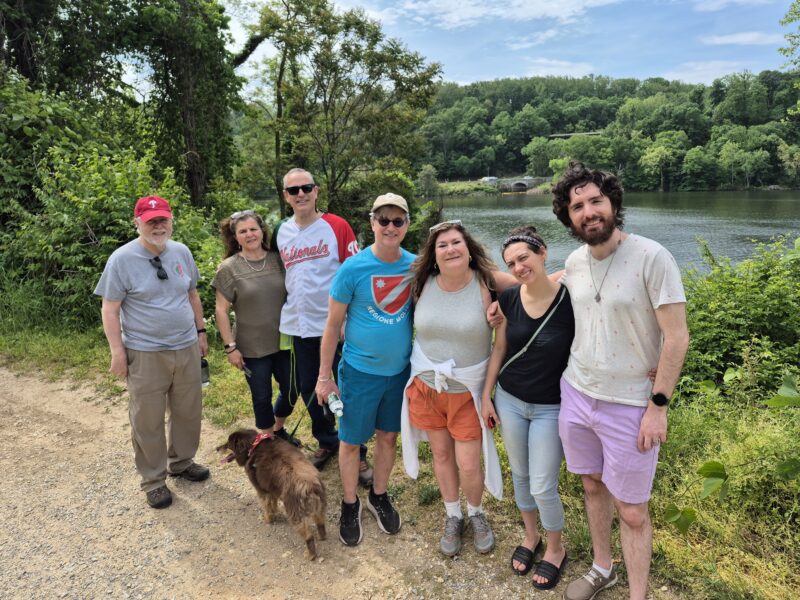
Enjoying a sunny day along the canal on May 3 were: (l to r) Carmine Spellane, Maria Panetta Fanelli, John Fanelli (with their dog Lucca, named after the city in Tuscany), Albert Palantonio, AMHS Board Member Teresa Black, Dominique Renneker, and AMHS President Chris Renneker.
A small but hardy band of AMHS members and friends gathered in the Georgetown neighborhood of Washington, D.C., on the morning of May 3 for a short hike along the C&O Canal towpath. The cool morning gave way to a warm, sunny day. After about two hours, the group returned to the heart of Georgetown to the popular Italian restaurant Il Canale for lunch. The hike has now become an annual event.hristopher Renneker, our AMHS president, will be going to the Italian-American Future Leaders convention in Florida in January. Chris’ application to the Class of 2025 was accepted and he will be joining a network of young leaders and professionals from across the United States.
May Event Postponed
The AMHS’ scheduled event in May was postponed to be rescheduled at a later date. The event was to be held in conjunction with Casa Italiana and Holy Rosary Church to highlight the monthly briscola games and other activities. Look for an announcement on the new date.
Summer 2025

